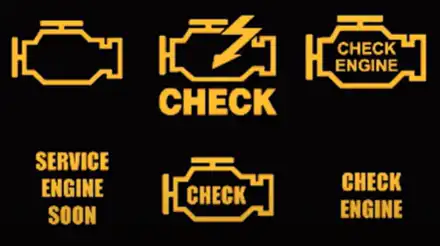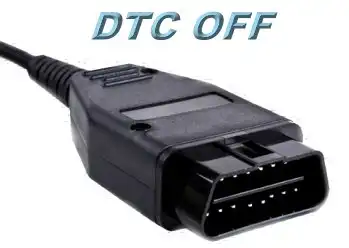What You will Read in This Article:
- Why your vehicle's "Check Engine Light" is on?
- What does DTC mean?
- What does the OBD II port do?
- Factors leading to DTCs
- Manual error removal and its disadvantages
- Advantages and Disadvantages of DTC REMOVAL SOFTWARE
- How to permanently delete ECU codes - DTC Removal/ DTC Delete/ DTC Off File Fault Code Removal

🔥You can watch our “DTC Removal Training Course” here.
Why your Vehicle's "Check Engine Light" is on?
The car Check light turning on can annoy any driver's, because you like it or not, it ultimately is a sign telling you there is a problem with the car, and you may have to spend some cash. The Malfunction Indicator Lamp (MIL) is often turned on when your car's Onboard Diagnostic System detects a problem that usually produces 1.5 times as much greenhouse gas emissions as allowed. In fact, if any of the components of your car is not functioning properly and, this system will turn on the engine check light to warn you (the vehicle driver). Apart from check lights, there are other warning lights, such as lights for coolant temperature light, oil pressure, batteries, etc., that, if left ignored, can damage your vehicle seriously.
What Does DTC mean?

DTC or Diagnostic Trouble Code is a code composed of one letter and four numbers indicating the vehicle's problem. This combination can include several thousand error codes that are detected and removed by mechanical engineers or technicians using different applications. Set following the SAE J2012 standard, these codes are divided into generic and extended codes. The extended codes are specific to manufacturers, but generic codes are programmed and standardized so that they can be decoded, regardless of the vehicle brand or model.
- Now, for a complete understanding of these error codes, let us use an example. Consider the following error code:
P0300 : The example error code above is a common error in cars, referring to "misfire in one or multiple cylinders."
- In general, the first letter represents four main modes, including:
P: Powertrain B: Body C: Chassis U: Undefined
- The first digit on the left has only two modes: 0 or 1 (there is also a limited number of codes with the first digit starting with 2
0: Generic code, shared by all manufacturers 1: Manufacturer specific code
- The second digit from the left should be between 1 and 8:
1: Emissions Management (Fuel or Air)
2: Injector Circuit (Fuel or Air)
3: Ignition or Misfire
4: Emissions Control
5: Vehicle Speed or Idle Control
6: Computer or Output Circuit
7: Transmissions
8: Transmissions
- The last two digits refer to code definition, which can range from 00 to 99. These two digits usually come together. For example, P0302 indicates misfire in the second cylinder, or P0312 indicates that the twelfth cylinder is experiencing misfire.

🗯Some other trouble codes include:
P0420: Catalyst converter system efficiency (Bank 1) is below the threshold
B0768: Service System Indicator Circuit-High Voltage
C0710: Faulty Steering Wheel Angle Signal
P1730: Faulty pressure switch 2- engine pressure
What is an OBD II port? What Does The OBD II Do?

The OBD II port or JOBD (in Japan) is a port around the steering wheel of the vehicle by which we can connect to the ECU (and also TCU) using various devices, such as car scan tools, and read various data, including accurate error codes, about the vehicle. The decision to use OBD II or On-Board Diagnostics became official in 1996 and was fully enforced for petrol vehicles in 2001 and diesel vehicles in 2004. Before the idea of installing the OBD II port, connecting to the car and troubleshooting it was a difficult process, and it had to be done
By various methods and with sheer difficulty, but following the introduction of OBD II ports, connecting to the car is really easy now, and you do not have to an expert to troubleshoot your vehicle.
Factors Leading To DTCs:

As mentioned earlier, fault codes have great diversity, and their showing up can indicate faults and defects in different parts of the car. Therefore, if you observe any error code(s), you better take it seriously to prevent further more serious problems in the future.
Although fault codes are permanently removable using the vehicle's ECU, removing them does not necessarily mean the fault with the vehicle's component(s) is resolved since the faults may have been caused by a car accident and mechanical defects of components. Repairing the vehicle or improperly using it can also lead to error codes.
You should also remember to check the DTCs regularly. Timely troubleshooting and investigation of DTCs by proficient specialists is critical and prevents more serious problems and high costs.
What is SPN codes?
SPN codes are a method of displaying fault codes that are primarily used in trucks.
However, manufacturers often interpret or implement SPN codes differently.
SPN codes also have both standard and specific display modes.
Some manufacturers add their own custom SPNs, which may not be found in generic code lists. These are often used for manufacturer-specific diagnostics.
Although SPN codes are a standardized method and many manufacturers use them, many manufacturers still use generic codes or DTCs as well.
Different manufacturers assign SPNs to specific Electronic Control Units (ECUs) in different ways, leading to variations in how the codes are reported.
Some manufacturers use their own diagnostic software, which may show SPN codes differently or require conversion to another fault code system.
These are some example of SPN codes:
84: Accelerator pedal sensor fault
411: Engine coolant temperature sensor fault
1569: Engine protection system active
5596: EGR system fault
Manual Error Removal and Its Disadvantages:
There is a manual, temporary solution for removing error codes and turning off the check light. After safely parking the car on a flat surface, we first remove the negative cable (black) and then the positive cable (red) from the battery terminals (Watch that the positive and negative cables do not touch each other). Then, press on the vehicle's horn for about 30 seconds to drain all the stored power and energy within the ECU capacitor. Advisedly, wait about 15 minutes before reconnecting the battery. Then, after reconnecting the battery, check the turn the ignition on and see if any error light is on. They are probably gone (although this method does not work in all vehicles).
Although we have walked you through this method, we do not recommend it at all, because as described in the previous section of this article, this method is not only temporary and can cause various problems in the long run, but can also mess up the settings of different parts of the car, such as the clock, radio, electric seats, steering wheel, etc. Moreover, this method is highly likely not to be able to remove the error codes permanently.
How To Permanently Delete ECU Codes - DTC Off Solution:
There are several Softwares for Fault code removal including Swiftec and Software WinOLS (Note that ECM Titanium cannot remove fault codes). To remove DTCs, Swiftec offers a richer functionality than WinOLS because it presents a smoother and more convenient fault removal process, but in WinOLS, removal is harder and more time-consuming. All in all, we use different softwares as needed, and in each software, removing DTCs needs a specific approach.
Besides, we give you the DTC Removal instructions in each of the mentioned applications so that you can select the one you are most comfortable with.

How To Remove DTCs:
🏁At CaracalTech, we help you remove fault code either using car scan tools or directly from the ECU and rid yourself of the check lights. Besides, we help you detect your vehicle's need for further serious repairs and start the repairments sooner.
DTC Delete Cost By Remap?
DTC removal price differs from cars and in CaracalTech we can do it for you with the lowest price and we do our best with guarantee and support
Here, you can learn once, fully and for good, the adjustments or removal of DTC from ECU.
Here is a link to a DTC training video in various softwares and ECUs.
1- If you want to learn how to delete of DTC in diesel and petrol engines in WinOLS software, you can enter to our ECU training course.
2- If you need only DTC off file, upload original ECU file in Tuning File Service, after short time our experts send you remapped file.
3- If you know remapping software like WinOLS or ECM, for ease and accuracy of work you can use CaracalTech Mappack in the following link.
📍For more information and probable problems feel free to contact us: support@caracaltech.com
